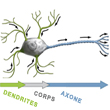Monday, 28 October 2013
Christof Koch, a Romantic Reductionist

Just in case the 2012 Summer School on the Evolution and Function of Consciousness in Montreal did not quench your ravenous thirst for knowledge on the subject, I am providing a link below to a recent Brain Science Podcast interview with Christof Koch, another great name in consciousness research.
Author of the book Confessions of a Romantic Reductionist, Koch argues that we are no longer confined to philosphical speculation about human consciousness, but instead can now make predictions and test them experimentally. (more…)
The Emergence of Consciousness | Comments Closed
Monday, 14 October 2013
Axons Play Unexpected Role in Processing Information

Recently, someone asked me whether it would be fair to say that the integration of all the information that one neuron receives from other neurons takes place in its dendrites. I replied that according to the classic model of neural communication, that is certainly the case, but that processes in living organisms are highly complex, so I probably shouldn’t make that statement categorically, if only because some integration also occurs directly in the neuron’s cell body. (more…)
From the Simple to the Complex | No comments
Tuesday, 1 October 2013
We Are All Complex Networks

Before the Harper government’s budget cuts, the CIHR Institute for Neurosciences, Mental Health and Addiction (INMHA) had been providing this web site with stable funding for over 10 years. As a result of these cuts, the INMHA had to stop funding us. Now, because of the same cuts, we have had to stop publishing new posts on the English version of this blog every week and will instead be doing so only once every two weeks. We are truly sorry, but that is the best that we can can manage on a volunteer basis. So here is this week’s post. The others will follow at two-week intervals from now until further notice.
*
In some previous posts in this blog, I have talked about the RSA Animate knowledge-visualization videos and the Brain Science Podcast, and I promised that I would mention other videos in these two excellent series on occasion. Well the most recent RSA Animate video and the most episode of Brain Science Podcast complement each other so well that this week I want to tell you about both of them at the same time. (more…)
From the Simple to the Complex | Comments Closed
Monday, 16 September 2013
Brain Rhythms: The Oscillations That Bind

Most of the neurons in the human brain emit nerve impulses (also known as action potentials) at a specific frequency, which may vary from just a few per second to several hundred per second. The chaotic brain activity revealed by an electroencephalogram (EEG) reflects the summing of all these oscillations in the billions of neurons in the brain.
Not so long ago in the history of neuroscience, the chaotic nature of all these oscillations caused them to be regarded as background noise and given little attention, or even dismissed as an epiphenomenon of no importance. But times have changed. The temporal dimension of brain activity, as expressed by these brain rhythms, is now central to neuroscientific research on complex topics such as sleep and consciousness. (more…)
The Emergence of Consciousness | 1 comment
Monday, 9 September 2013
Why You Can Have No More Than About 150 Real Friends
 So you’re proud that you have 500, or maybe even 1000, friends on Facebook? Sorry to tell you, but you probably have far fewer, if we are to believe Robin Dunbar, a professor of evolutionary anthropology at Oxford University in the United Kingdom. As few as 150, in fact: this is the famous “Dunbar’s number”, a limit of about 150 people above and beyond which it is supposed to be impossible to maintain true friendships. (more…)
So you’re proud that you have 500, or maybe even 1000, friends on Facebook? Sorry to tell you, but you probably have far fewer, if we are to believe Robin Dunbar, a professor of evolutionary anthropology at Oxford University in the United Kingdom. As few as 150, in fact: this is the famous “Dunbar’s number”, a limit of about 150 people above and beyond which it is supposed to be impossible to maintain true friendships. (more…)
Evolution and the Brain | Comments Closed







